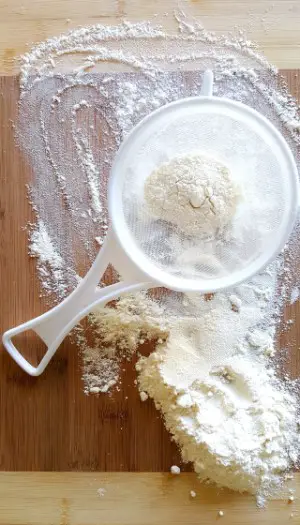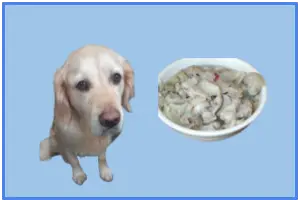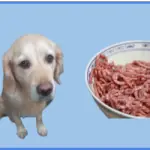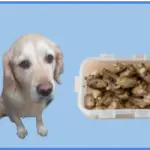
Why do dogs eat flour?
Some dogs flour just because it is there.
Or just because it sits behind a cupboard door which is slightly ajar and their Mum and Dad have gone out.
If scientists aren’t quite sure why dogs eat grass, then there definitely isn’t just one reason why a dog might eat flour.
Flour is one of those strange foods.
Clearly when mixed with other ingredients it can become beautiful but on its own, it’s a very unattractive thing even for a dog to attempt to eat.
Pica is a medical diagnosis that is given to dogs who regularly eat non food items and flour seems to me to sit on the boundaries of that definition.
One thing that is clear is that flour shouldn’t be a large part of your dog’s diet as there is not much nutrition in it.
This analysis shows that it is over 70% carbohydrate.
My dog ate flour what should I do?
If your dog has just gorged themselves on flour then depending on how much they’ve eaten will determine how quickly they will recover.
Flour isn’t toxic to dogs and so your dog should make a full recovery from eating it.
The exception to this rule is for dogs who have a gluten intolerance but I shall discuss that in much more detail in a later section.
If your dog has had a large amount of flour (and by that I mean more than a few licks out of a bag) you can expect your dog to either to vomit at some point pretty soon or to have one or more episodes of diarrhea.
And it won’t be a very comfortable experience for your dog.
I mean just imagine that lump of flour moving through your dog’s system- you can expect them to look a bit sorry for themselves because they will probably have a bit of a stomach ache.
It is important to give your dog access to plenty of fresh water.
Not only will the water help to soften the lump of flour, your dog will need something for their throat which might be lined with flour and very dry.
And if your dog is up for it, I would suggest that you feed them as usual but maybe give them a smaller portion.
Expect your dog to be a bit “off colour” for about twenty four hours but if they show any symptoms beyond this.
What are the biggest selling flours?
The range of flours that you might find in any of our homes is truly staggering.
The mainstays include all purpose flour and self raising flours but as time has moved on.
And traditionally the flours we all used were all made from wheat.
But things are different now.
Flours are no longer made from just wheat but other grains such as rye, barley, corn and rice have become much more popular and much more likely to be in people’s cupboards.
But does this greater variety of flours increase the risk to our dogs?
Are any of these “newer” flours more dangerous or toxic for our dogs?
I will look at this in the next section
Are any flours toxic to dogs?
Because dogs aren’t naturally allergic to wheat or any other grain (rye, barley, corn, rice or whatever) then the overwhelming majority of dogs are fine with any type of flour.
Although they aren’t particularly nutritious for dogs, none of them are toxic for dogs.
But there are two possible exceptions to this general rule- gluten intolerant dogs and self raising flour.
Now I will look at gluten intolerance in a later section of this article but I will talk a bit about self raising flour now.
Most bags of flour contain one ingredient- the “powder” of a specific grain.
Self raising flour is a bit different because a bag of it contains ground flour, baking powder and a bit of salt.
Some of you might be worried that self raising flour poses specific dangers to our dogs.
And you are right to be cautious about adding baking powder and salt to a dog’s diet but the amount of baking powder or salt in a bag of self raising flour is so small that they shouldn’t concern you unduly.
I mean if your dog starts snaking on a bag of self raising flour, be far worried about the amount of flour that he has eaten rather than what the baking powder or salt will do to him.
To help you, self raising flour contains about three percentage of baking powder and half a percent of salt.
In the next section, I will look at another exception which is a real danger- bread dough.
The dangers of bread dough
If your dog eats flour, they should be fine. It is the same with bread.
Neither of these ingredients should form a large part of their diet but as an occasional treat or “accident”, your dog should not suffer any lasting damage.
But most bread dough is a completely different animal.
Many dog owners also bake their own bread and I know this because it was something that I did a lot a few years ago.
The thing that you need a lot of, whilst baking your own bread, is time because bread dough needs time to prove or rise.
If you have a dog that is a worktop thief, this could be a time that the dough accidentally disappears.
And bread dough presents a “clear and present danger” to your dog because of the yeast which is at work within it.
It is the yeast which turns the small lump of dough into a much larger lump of dough.
And if your dog has eaten the bread dough there is a danger that the transformation will now be happening in your dog’s stomach.
The first issue is that this larger lump of dough will become a blockage somewhere in your dog’s system.
Or in rare cases it could cause bloat.
The second danger is alcohol poisoning. As the yeast ferments, alcohol is released- straight into your dog’s blood stream.
Effectively you have a drunk dog with the same symptoms as a drunk person but a glass of water, aspirin and a good night’s sleep won’t cure your dog.
Only a trip to the vets will.
So where does that leave other types of bread dough?
If you are one of the many people who love to make their own tortillas, then you can breathe a sigh of relief.
Tortilla dough doesn’t contain any yeast and so if you dog does a smash and grab raid on your stash of “dough” then they are in for a sticky, tasteless and uncomfortable time but it probably won’t involve a visit to the vets.
What other common dog “foods” are flour and wheat in?
Most commercial dog foods have wheat in, although there is a much wider selection of foods which are grain free that are now available for people to buy.
This dog kibble is one of the best selling dry foods on Amazon and it uses whole grains. , has ground whole grain wheat in it.
Many of your favourite dog biscuits will have flour in them, such as the range of “milk bone” treats.
Gluten intolerance in dogs
Gluten is a protein found in wheat and a person with a gluten intolerance has an allergic reaction to it.
Reactions are many and varied and may include things like bloating or constipation.
It is thought that around 1% of people are gluten intolerant, it is not known how many dogs are affected by this condition.
But here is an intriguing article about gluten intolerance in setter dogs.
In dogs, gluten intolerance could reveal itself through hair loss and dairrhea.





